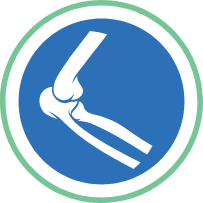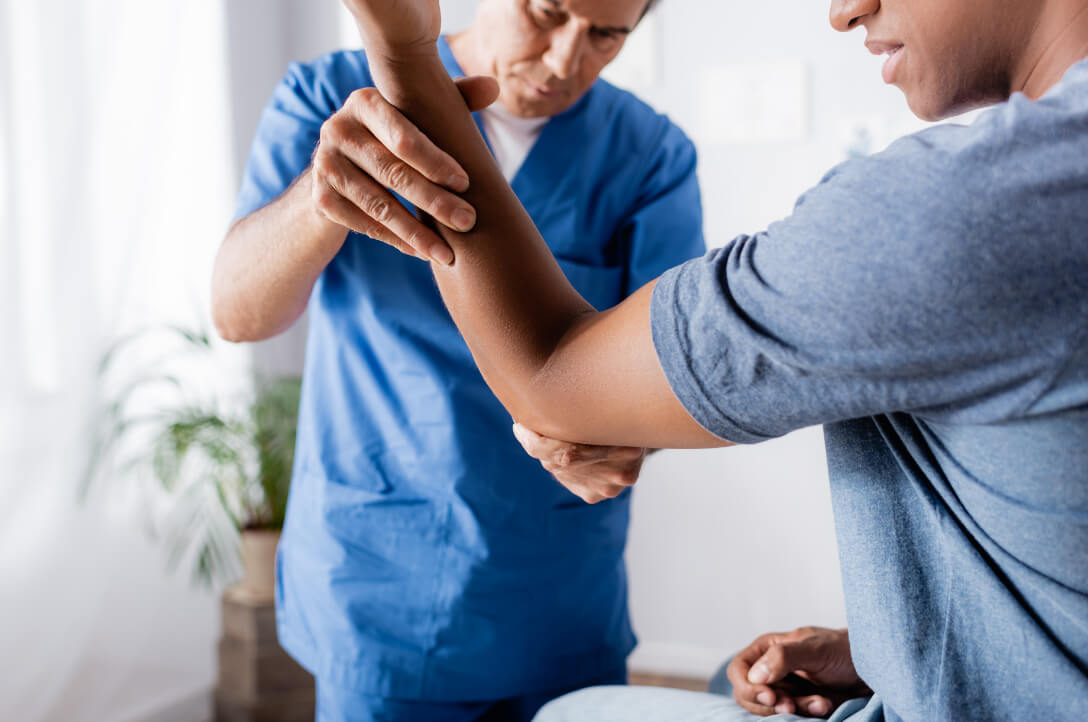

Orthopedic Elbow Care
An elbow injury can bring a quick end to your ski season or even put you out of work. If you’re like many Alaskans, you likely live an active lifestyle and enjoy the many activities Alaska has to offer.
Unfortunately, it is often these very activities that put you at risk of injuring your elbow. Swinging a golf club or tennis racket, for example, can lead to overuse of the elbow joint and the ligaments and tendons that surround it. Sudden accidents, like falling while hiking your favorite trail, can cause more severe injuries.
If your elbow has become painful, difficult to move, or inflamed, make an appointment with our experienced orthopedic specialists. You’ll meet with your doctor one-on-one from the first visit and the quality care you need to return to the activities you love.

Common Elbow Issues We Treat
Cubital Tunnel
A condition that occurs when the elbow’s ulnar nerve is compressed, pinched, or irritated due to increased pressure in the cubital tunnel. Symptoms include pain when touching the elbow, numbness or tingling sensations in the ring and small fingers, or general weakness in the hand.
Distal Bicep Tendon Rupture
An injury affecting the distal bicep, a tendon that attaches the bicep muscle to the elbow bone. Ruptures may occur when lifting heavy objects, which can place increased tension on the bicep muscle causing the tendon to tear.
LUCL Injury
A tear to the elbow’s lateral ulnar collateral ligament, which is located on the outside of the elbow and provides it the most stability. Repetitive throwing motion, elbow dislocation, or other acute injuries can all cause a tear in the UCL, leading to issues in the elbow such us locking and clicking, loss of motion, or recurring dislocation.
MCL Injury
The medial collateral ligament is located on the inside of elbow and is made up of three bands that work together to stabilize the elbow joint. Increased stress on the elbow due to forceful twisting or bending motions can cause one of these bands to rupture. Patients may experience swelling and bruising, loss of motion, and pain when making a fist.
Tennis Elbow
A condition characterized by pain on the outside of the elbow and sometimes the wrist and forearm. It is a type of tendinitis, or swelling of the tendons, that is often caused by repetitive motions that place stress on the elbow tendons.
Elbow Dislocation
The elbow become dislocate when any of the bones in the elbow become misaligned, which can make the joint look disjointed and cause extreme pain. Children may experience elbow dislocation from being swung or yanked on by the arm. Other common causes of dislocation include overuse, car accidents, or falling on an outstretched hand.
OCD Elbow
A common injury for active adolescents, osteochondritis dissecans of the elbow that results from repeated overhead motion, such as throwing a ball, doing gymnastics, or playing tennis. This condition can cause stiffness, clicking, and locking of the elbow.
Osteoarthritis of the Elbow
A type of arthritis caused by wear and tear of the elbow bone’s cartilage over time, often causing pain, swelling, and difficulty bending the arm. Previous injuries can contribute to OA of the elbow, and symptoms can worsen over time as the degeneration progresses.
Elbow Fracture
Fractures can affect the ulna, radius, or humerus of the elbow. Elbow fractures are especially common in children from incidents like playground accidents, falling off bikes or scooters, or running and jumping outside. Most fractures occur from falling directly on the elbow, falling with an extended arm, or getting hit by a moving object.

Orthopedic Elbow Treatments
While elbow pain and injuries may be common for people who live a healthy lifestyle, there are treatments available to help alleviate painful symptoms and get your elbow working like it should. Whether dealing with an acute sports injury or pain that’s developed after years of working the same physical job, our orthopedic specialists can get to the root of the issue and discuss the best options for treatment.
A combination of nonsurgical options may be all you need to get back in the action. These may include resting for four weeks or more; reducing inflammation with medications, ice, elevation, or other methods; wearing a supportive strap; and starting physical therapy to help strengthen the muscles around the elbow joint. If your injury is too severe or conservative methods aren’t getting you the results you want, our orthopedic surgeons will discuss what minimally invasive procedures and surgical options are available to help you.

